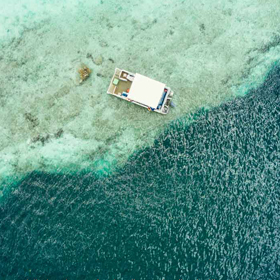- This adventurous itinerary covers all the natural wonders of the south-west of Africa
- Driving on Namibia's tracks, the desert/sea/swamp landscapes, the spirit of the bush, 'braai'
- Mountain biking in Swakopmund, private splashes in Victoria Falls and spotting Chobe's elephants are already included!
- You'll have access to our additional services, including our local Concierge
Contact one of our specialists + 44 (0) 20 3958 6120
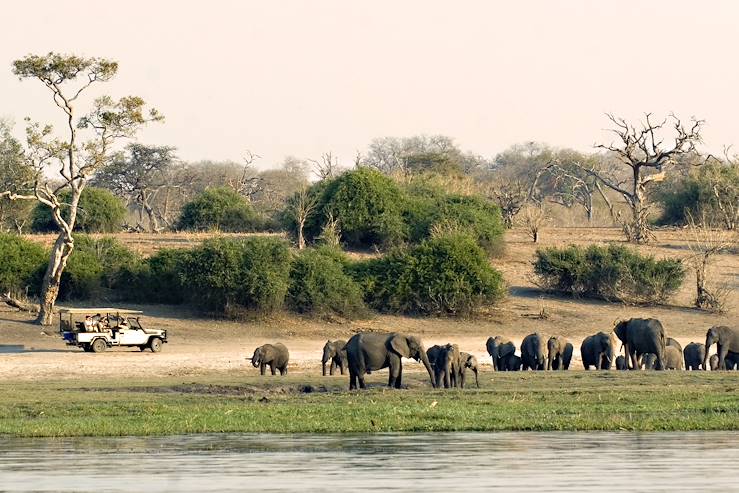
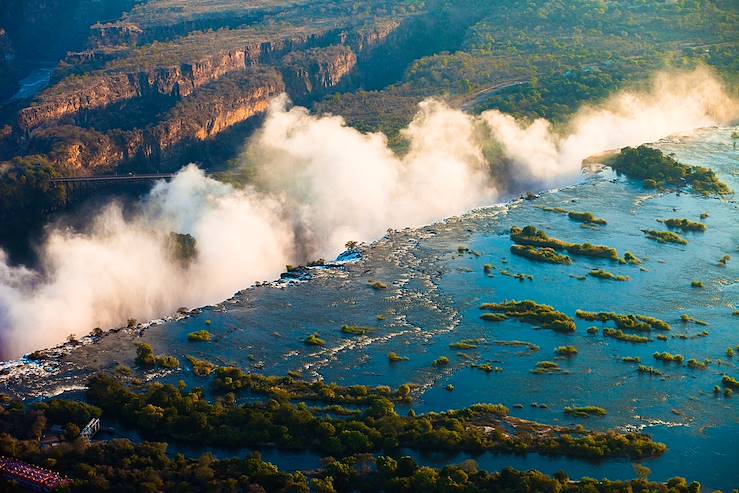
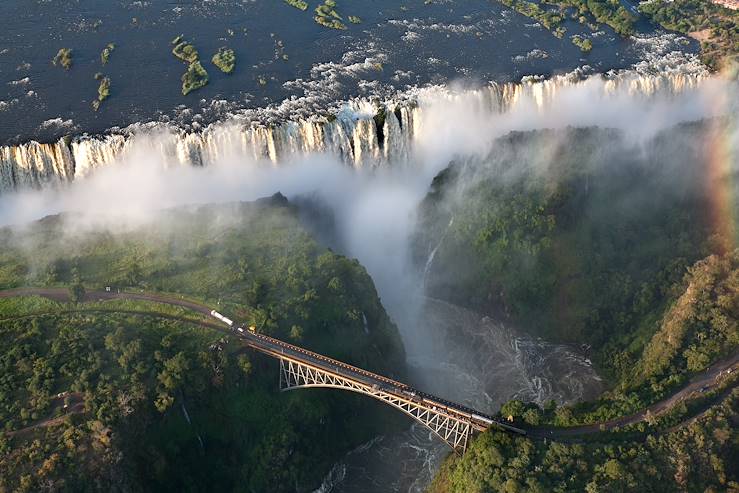

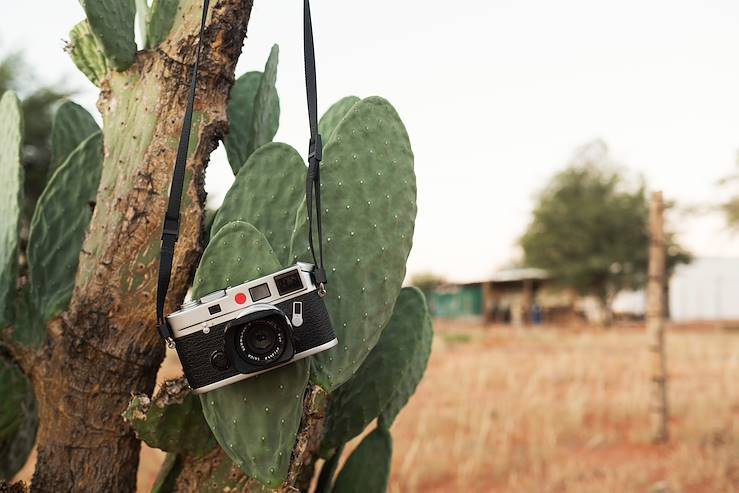
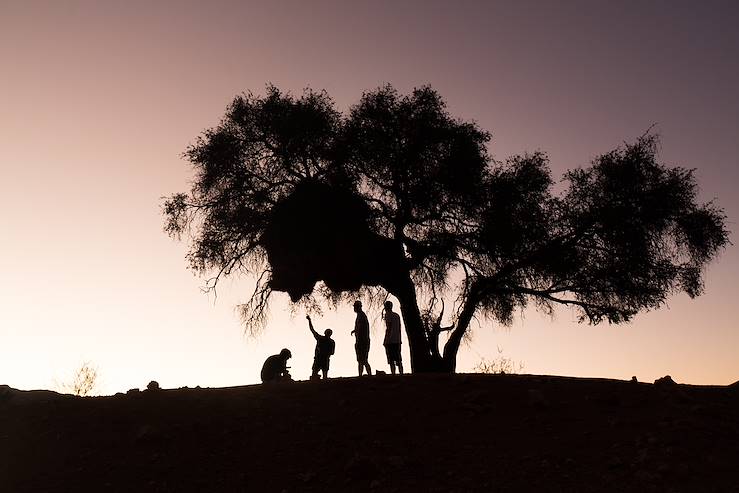
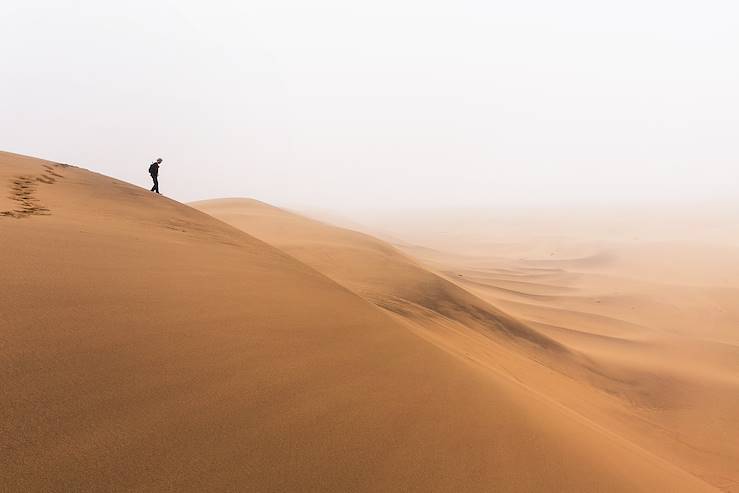
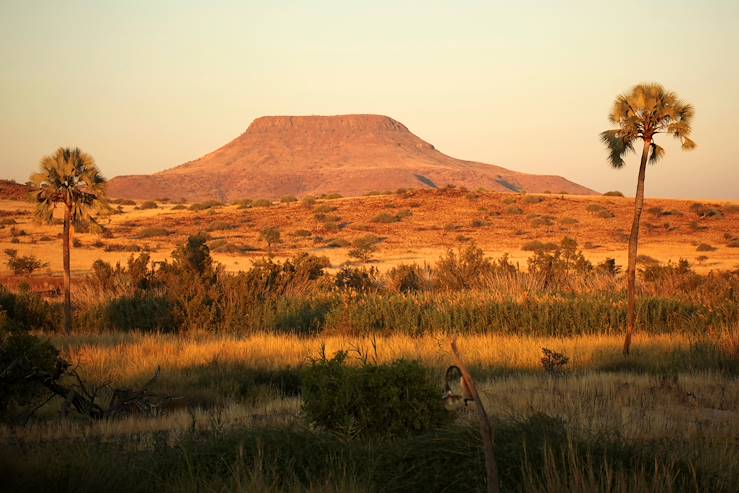
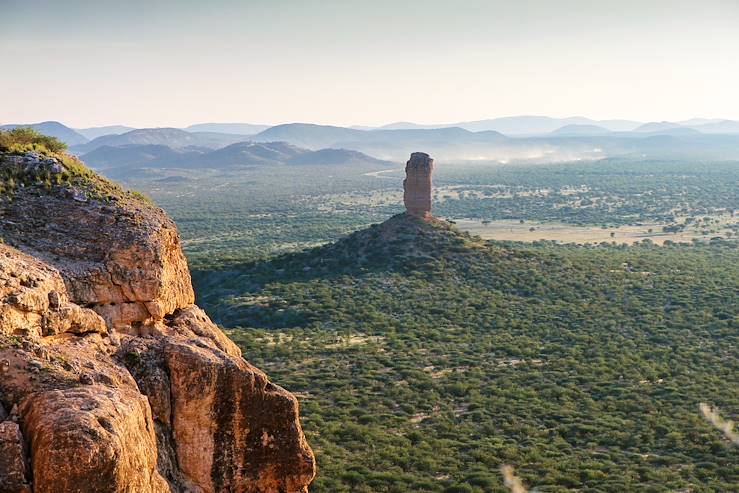
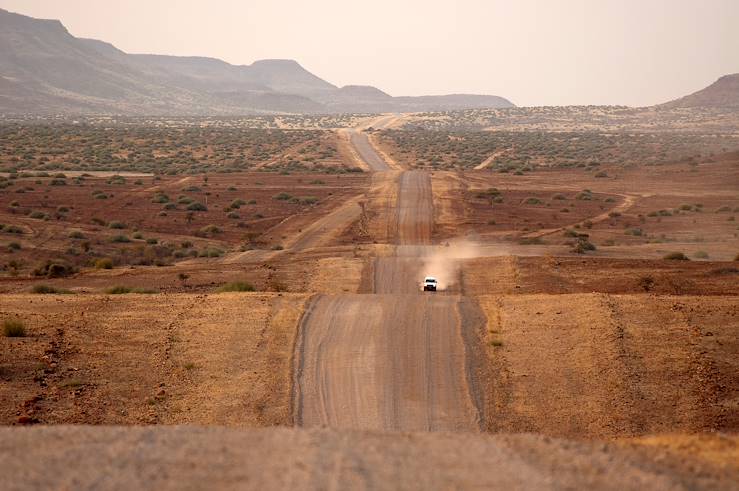
South-west Africa
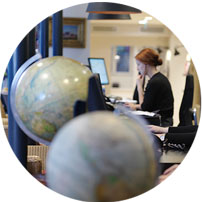
The trip
The terrain varies throughout the trip and so does the method of transport. 4x4 or SUV is the way to go on Namibia's roads and tracks, but along the canals of the Okavango Delta, you'll travel in a dugout canoe. In Namibia, you drive; in the Okavango, the paddling is done for you. Between these two extremes of the journey, you'll travel by planes, air taxis, and all-terrain vehicles with drivers. We've ensures that your itinerary maximises your time in your destination, and that your accommodation is comfortable and practical, with half board or full board almost everywhere. The Sesriem lodge, Victoria Falls Hotel and the Okavango tent camp will help you to create the fondest of memories. Activities include biking in Swakopmund's dunes, a private tour of Victoria Falls, safaris in Chobe Park and exploring the Okavango. In Namibia and Botswana, if there is an issue or if you have a last minute idea our local Concierge service is on hand to help. Offering cultural insights, practical support and good ideas, they are first-class contacts.Route
Fly to Windhoek, Namibia
Windhoek
You'll have a warm welcome and assistance with formalities. Pick up your rental vehicle and cool box and travel to Eros Park where you'll stay overnight. The hotel is an immaculate building with a modern design. The swimming pool offers cool respite from the heat, and the interiors are comfortable so that you can relax after a long day. The restaurant serves Namibian and international cuisine. In short, perfect for recovering from the flight and getting ready for the adventure.
Windhoek - Omaruru
Drive to Omaruru. Overnight stay in Erindi Private Game Reserve. The lodge is set on the edge of a reservoir frequented by animals. The thatched bungalows fit in seamlessly with the natural setting. It has a classic safari feel. The room is a good size, has a seating area, a private bathroom and opens out onto the illuminated water in the evening. You can spot the wildlife from the door. The chef delights guests with fresh and varied dishes, drawing some of the ingredients from the house's own vegetable garden. The pool is perfect for relaxing in.
Spiny bush, savannahs, and rocky outcrops form the landscape of the reserve. On your trips out, you'll encounter numerous carnivores - from lions to the Angolan slender mongoose - plus cute herbivores such as elephants and scrub hares, and a grumpy omnivore - the warthog. Ornithologists will be delighted to spot the crimson-breasted shrike, red and black gonolek, the inseparable rosy-faced lovebirds or the violet wood hoopoe.
Omaruru - Vingerklip
Drive to the Ugab Valley, between Outjo and Khorixas. Spend two nights in a lodge with 15 simple and comfortable chalets. The rooms are decorated with designs featuring elephants, snakes, giraffes, guineafowl and other local animals, and traditional furnishings. From the private verandas, you can look out over panoramic views, and enjoy either sunrise or sunset depending on the chalet's location. The lounge and dining room also open out onto the outside. In the morning, an English breakfast is served. An ideal way to fuel up for the day's adventures, The pool, dug into the rock, is hidden in the folds of the terrain. Smiling and helpful staff enhance the enjoyment of the stay.
Vingerklip
Around the lodge, the landscape looks like an African version of Arizona. The Vingerklip or 'stone finger', is a 110ft-tall limestone pinnacle, shaped by erosion. This is the eastern entrance to Damaraland. The rock art site of Twyfelfontein, in the Huab Valley, is a must-see. The hunter-gatherers of the Stone Age, and then the Khoikhoi herders, adorned the site with petroglyphs and paintings. Slender images of giraffes, lions, antelopes, elephants and bow hunters evocatively brought to life. It is now a UNESCO World Heritage site. In the Brandberg mountain range, the San people also left behind numerous paintings. About 18 miles from Khorixas, the fallen trunks of the petrified forest are between 250 and 300 million years old. It's a mindblowing thought.
Vingerklip - Swakopmund
Drive to Swakopmund. Enjoy a two-night stay a few hundred feet from the ocean. The hotel resembles many modern seaside resorts, but it is professional and well maintained. The classically designed rooms feature all the essentials. The rooftop swimming pool offers the delightful experience of swimming in fresh water open to the sea air. The restaurant serves wholesome fare, with a focus on seafood. The gym and massage services are the ideal way to unwind.
Swakopmund
A small and unchanged late-19th century German town. It now serves as a smart seaside resort. The iconic buildings include the Lutheran church dating from 1911, the old barracks built in 1906 - flanking the Hotel Prinzessin Rupprecht, a former Art Nouveau military hospital, built in 1902 - or the Hohenzollernhaus, built between 1904 and 1906, in the Neo-Baroque style. You can even see the 'Welwitschia mirabilis', an extraordinary, unique two-leaved living fossil plant on the arid coastline, included in the country's coat of arms with the sea eagle and oryx; some live specimens are over 1,000 years old.
Already included in the itinerary - Biking in the dunes: Go for a mountain bike ride, from the centre of Swakopmund to the dunes, about six miles along a dry river bed. Once there, ride up and down one of the oldest sand areas in the world. The sea breeze adds to the pleasure of the ride, all accompanied by a guide.
Swakopmund - Sesriem
Drive to Sesriem. Two-night stay around 20 miles south-east of the canyon. Without a fence to mark out its territory, the lodge seems to be part of the sheer vastness of the area. A large main building has comfortable communal areas with a low-hanging thatched roof, plus there are two wings of small houses where you'll find the bedrooms, with shaded terraces. The latter are in a rustic style, but are nevertheless cosy. They are air-conditioned too. Which is pretty impressive as the electricity here is all from solar power. Go back and forth between the living room, bar or dining room to socialise with the other guests. Horses are a major theme of the estate; sunrise and sunset rides are laid on, led by rangers.
Sesriem
Sesriem is the gateway to the Namib-Naukluft National Park, the largest of Africa's parks: At 19,000 square miles, it is slightly bigger than Slovakia. Away from the Atlantic coast, it's a generally arid region, and in some areas completely arid. The wildlife here has learned to survive, and some of the techniques are being harnessed by cutting-edge industry. And the fog stand beetle has captured the interest of researchers at MIT, intrigued by its method of capturing moisture from the air. The Sossusvlei region, a salt desert in a sand desert, is famous for its sea of sand dunes. They are orange sand dunes that change colours in the light and stand more than 1,000ft tall. Acacias act as wells, and collect water from as far down as 30ft. It's an unparalleled landscape.
Sesriem - Mariental
Drive to Mariental. Stay overnight on the edge of the Kalahari, in a small green estate on the reddish-brown outskirts of the desert. The lawns are meticulously well-tended. There are a succession of three pools: the swimming pool, an ornamental pond, and the reservoir, where wild animals come to drink: Roan antelopes, giraffes, cheetahs and more. Each suite has its own bathroom and terrace. Sample local produce and traditional flavours in the chef's delicious meals each day.
The landscape of the Kalahari is made up of long lines of reddish dunes separated by roadways, wide grassy plains where the acacias create a little shade. Large animals come to feed here, such as wildebeest, giraffes, kudus, oryx, etc. Yet the star of the show is only one foot tall and has no tail: the meerkat. These lovable creatures are all around.
Mariental - Windhoek
Drive to Windhoek. Your overnight stay is about 30 minutes north-east of Windhoek. out in the wilderness. This contemporary and eco-friendly building has been made from sustainable materials, but is still incredibly comfortable. The levels of quality, facilities and service are astonishing. Individual bays and verandas open onto rough landscapes, where hartebeest, gemsbok, greater kudu, giraffes, and baboons roam. The chef offers a modern take on traditional regional food and magics up a new African cuisine. And the pool offers the perfect opportunity for a dip.
Windhoek - Victoria Falls (Zimbabwe)
Return the car to the airport and fly to Victoria Falls via Johannesburg. Transfer. You'll have a two-night stay in a hotel from where you can see the clouds of water vapour from the falls. The rooms are pleasant, cosy and bright; and the lounges are furnished with glossy and crisp leather. The restaurant serves sumptuous African flavours. In the evening, on the terrace, under the stars, with the sound of the Zambezi, it's the perfect setting for a romantic meal. The swimming pool is great for a few lengths or for just relaxing.
Victoria Falls
Already included - Private tour of Victoria Falls. Visit the falls in the company of an expert guide. The Zambezi puts on a majestic spectacle. While the Main Falls drop a heavy white curtain into the void, the Devil's Falls are narrow and gushing, and Horseshoe Falls and Rainbow Falls tumble from the highest points. Narrow gorges intensify the effect of the water to create a truly incredible sight. The area's humidity means the flora surrounding the falls is abundant, with African mahogany trees, ebony trees, ivory palms and wild date palms dotted around the mopane-covered savannah. There are walkways for visitors to get a closer look.
There are also lots of walking opportunities in the area. There's bungee jumping from the famous Victoria Falls Bridge for thrillseekers; and rafting on the Zambezi, for those who don't mind a wet adventure.
Victoria Falls - Chobe National Park (Botswana)
Transfer to Chobe Park. Enjoy a two-night stay on a shoulder of land overlooking the Kwando River / Chobe. The lodge's bungalows are rustic yet comfortable. The nicely appointed rooms with private bathrooms have verandas that look out onto the valley. The pleasant surrounds are enhanced by the bar, dining room and pool. From building materials to everyday service, there is a consistent effort made to operate sustainably.
Chobe National Park
The Serondela area, north-east of the park, covers the floodplains on the south bank of the Chobe River. It is renowned for the sheer variety of its wildlife. Elephants are of course the big names here, but there is also the rare puku (Kobus vardonii), a graceful Kob, or the snakebird.
Already included in the itinerary - Two activities per day. Two land safaris in kitted-out vehicles. Or a land safari and a boat trip. All with a ranger who can guide you on your journey. Each way of approaching the different animals has its own charm and done right, the animals are not too afraid. In addition to the elephants, there are also hippos and Cape buffalos, warthogs and waterbucks; on firmer ground, there are impala, the harnessed bushbuck, the cheetah, and baboons; plus birds are one of the delights of the Chobe with Egyptian geese, African sacred Ibis, African fish eagles, blacksmith lapwings, and southern carmine bee-eaters, and more.
Chobe National Park - Okavango Delta
Transfer to Kasane Airport and taxi plane to the Okavango Delta. Your two-night stay is north of the delta, between the Vumbura River and the Selinda Spillway. Giant marulas, sycamore fig trees, and ebony trees shade the camp area. The tents, communal areas and rooms are erected on the wooden decks. The lounge, dining room and bar surround an outdoor fireplace. Unexpected amenities for the camper that add a layer of luxury. The chef draws inspiration from across Africa. The swimming pool may be small but it delivers big on well-being.
Already included in the itinerary - Exploring the Okavango Delta. Choose from the activities available from the lodge, including an outing in mokoro canoe, fishing, a village visit and more.
The Okavango Delta
This mixed environment is suitable for creatures as at ease on water as on land. Hippos are clearly at home here. Familiar faces to these waters are the lechwe, especially well-suited to spongy areas. If you're lucky, you can spot the large, golden Pel's fishing owl, which has become rare, but the delta provides it with a favourable habitat. The whistling voice of the osprey forms a big part of the soundtrack of the marshes. Elephants, buffaloes, lions, antelopes and giraffes are common and, on a good evening, you may even encounter a stealthy leopard, a serval or even a pack of African wild dogs.
The Okavango Delta - Maun - return flight
Taxi plane to Maun. Return flight via Johannesburg.
Optional - Johannesburg and Gandhi's House.
A la carte
Johannesburg and Gandhi's House
Since you're stopping off in Johannesburg, why not take a closer look at South Africa's most creative city after dropping off the luggage at Satyagraha House? Located in the suburb of Orchards, the house where Gandhi lived between 1908 and 1911 is now a museum dedicated to him, as well as a guesthouse based around the principles that inspired the future Mahatma's famous philosophy. The bright and simple rooms here (two of which face directly into the museum area) are comfortable without being extravagant, while the vegetarian cuisine on offer is tasty and fortifying. This historic Kraal designed by Hermann Kallenbach and the contemporary building by Rocco Bosman each pay tribute to the spirit of openness and peace that inspired one of the great political and humanitarian minds of the 20th century.Optional
A Rough Idea of Price
- Air travel
- Airline taxes and fuel surcharge
- Reception and assistance at Windhoek Airport
- A food and drinks cooler
- In Namibia, ten-day rental of a 4x4 vehicle
- Reception and assistance at Victoria Falls Airport
- Private transfers
- Overnight stay in Windhoek in a double room with breakfast
- Overnight stay in Omaruru in a double room with half board
- Two-night stay in Vingerklip in a double room with half board
- Two-night stay in Swakopmund in a double room with breakfast
- Mountain biking, with an expert guide
- Two-night stay in Sesriem in a double room with half board
- Overnight stay in Mariental in a double room with half board
- Overnight stay near Windhoek in a double room, half board
- Two-night stay in Victoria Falls in a double room with breakfast
- Private tour of Victoria Falls with guide
- Two-night stay in Chobe National Park in a twin chalet, full board
- Activities to explore the park
- Two-night stay in the Okavango Delta in a twin tent, full board
- Activities to explore the delta
- A local mobile phone
- Our Concierge service in Namibia and Botswana
Our local concierges
Travel diary app
UK airport lounge
CO2 absorption

